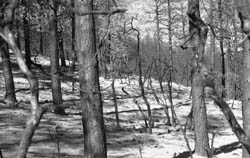|  Finding
consensus Finding
consensus
Despite these apparent polar
opinions, there is one local agency that may be able to strike
a true “middle ground”: the San Juan National Forest.
Dave Dallison, the forest’s timber project leader, advocates
restoration forestry and believes commercial logging can be a
component of this kind of wildfire mitigation.
He said there is a project near
Dolores where the Forest Service is using commercial logging to
thin from below, removing smaller trees with little value, and
then applying controlled fire.
“Our intent is to leave
the largest trees in a clumpy structure and reduce the density,”
he said.
Dallison, a fire-behavior analyst,
spent a great deal of time on the ground fighting the Missionary
Ridge Fire and says that something has to be done about the state
of local forests. However, he notes that any fix will take time.
“I believe we do need
to do something, but it took us 100 years to get into this problem,”
he says. “It’s not going to be solved in a few years.”
He also adds that commercial
logging is just one of the tools the Forest Service taps for forest
health. Others include restoration forestry, hydro-mulching, controlled
burning and mechanical removal of trees.
“We need to use all the
tools we have available to us,” he says. “We’re
going to choose the right tool.”
Suitable streamlining
As for the McInnis bill, Dallison
would not mind seeing environmental review streamlined. “I
know that with timber, about 70 percent of our costs are doing
the environmental assessment,” he says. “It would
be nice if we could put some of that money toward improvements.
I don’t think it would change what we’re doing on
the ground, and it would allow us to treat more acres.”
He also notes that involvement
of the timber industry can be beneficial in terms of taxpayer
costs. However, he also remarks that local logging has seen better
days with many loggers being small businesses with limited markets,
courtesy of the recent closure of the Olathe Louisiana Pacific
plant.
“Really, the timber industry
in this area is in bad shape,” he says. “If we lose
it, it’s going to cost the public a lot more.”
In closing, Dallison says, “I
would not expect a wholesale change in the way we do business.
We’re not going to run out there and do a bunch of logging
that doesn’t make sense.
Likewise, Pearson said he has
confidence in San Juan National Forest officials and credits them
for a decade of attention to public needs. “I don’t
think this forest will try to ramrod things through with less
public input,” he says. “I think they’ve learned
that they can be much more successful by building consensus.”
And McInnis bill or no McInnis
bill, the local forest will be responsible for its relations with
the local populace. As for the Healthy Forests Reform Act, the
Senate remained deadlocked over the bill on Wednesday with McInnis
wanting bi-partisan agreement on the measure.
“We’d like to achieve
bipartisan consensus on this,” Jones says in closing. “We
simply want to make NEPA a better system.”
|

